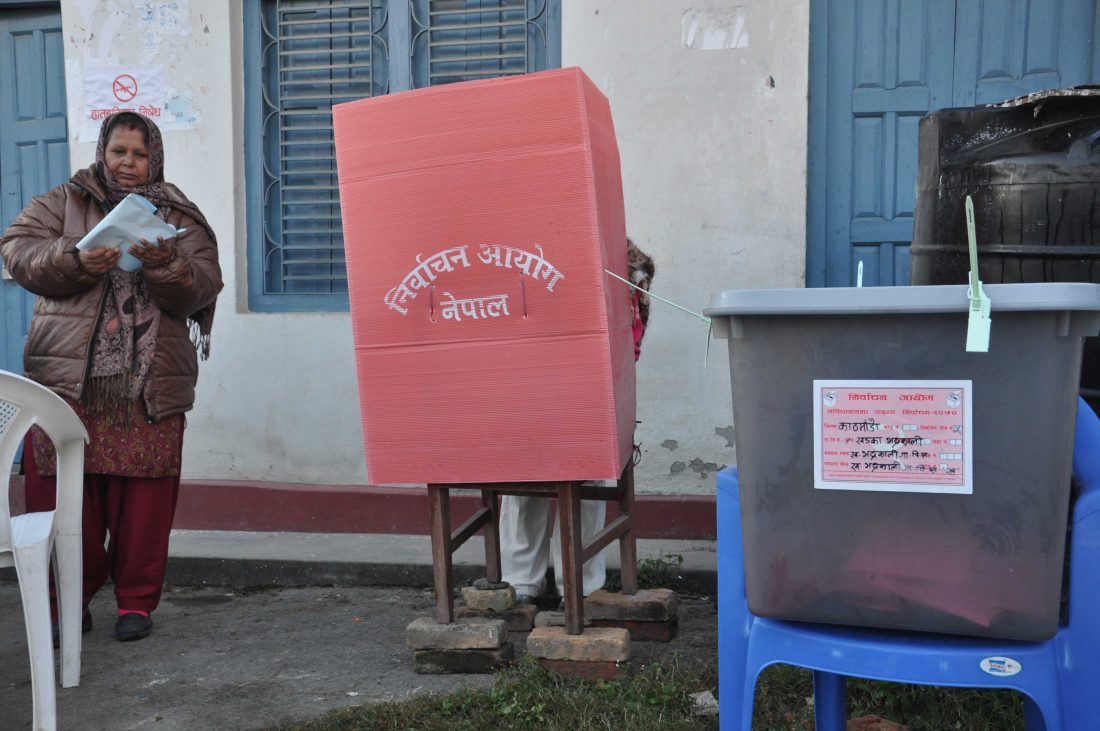
Voters cast their ballots in Nepal’s 2013 Constituent Assembly elections. On May 14, Nepalis will go to the poll again in local elections.
The local elections will be a significant step toward implementation of a new constitution that mandates a restructured nation-state reflecting for the first time in Nepal’s history a federal, secular republic with a plural political order and inclusive social character. If successfully concluded, the elections will instill confidence and ownership of the constitution in the general public and rebuild trust in the country’s choice of system of political representation. Additionally, successful local elections would ease the path for the two following elections to provincial and national government. Thus, local elections are closely linked with institutionalization of the new constitution.
The election will also fill a longstanding political void at the local level. Local elections are being held after a long gap of 19 years and for only the third time since the advent of multiparty democracy in 1990. For almost two decades there has been an absence of elected officials at the village level and a palpable lack of local representation of concerns, interests, and needs in the country’s public policy and administration.
In the 1990s, the government tried to bridge the ever-widening gap between the state and citizens by promulgating the Local Self-Governance Act which attempted to give more autonomy to local governments. However, resource and capacity constraints at the local level combined with the decade-long conflict significantly limited positive effects of the well-intended Act. Most tragically during this period, elected local governments were dismissed and civil servants authorized to assume administrative as well as developmental functions. Combined with a provision of the interim constitution that required political consensus in government, these civil servants worked on behalf of all-party mechanisms that fueled syndicate-like behavior at the local level. The experiment was a governance disaster: the collusive tendencies among political parties, with no opposition and the lack of accountability checks and balances, had a detrimental effect on local-level democracy and state efficiency. Such arrangements not only formalized local corruption in Nepal but also undermined the formal procedures of governance and institutionalized nepotism, lack of transparency, and informal decision making.
By returning to participatory governance, next month’s local elections could halt and possibly reverse the downward spiral in local government mismanagement, culture of impunity, organized corruption, and citizen exclusion from decision-making processes that we have witnessed in the past 15 years.
Local elections would be a crucial step in addressing political marginalization and point the way to truly participatory democracy and inclusive development. For example, the constitution mandates each political party to nominate at least one woman for head or deputy head position in the election. This should promote women’s participation in public life from the grassroots upwards—even though the most recent constitution amendment proposal to remove local elected representatives from the national electoral college significantly jeopardizes that outcome.
Sweeping changes are probably coming to the country’s socio-political foundations that have survived for many years. The transition to a new structure will present opportunities and challenges at all levels of governance and society. At the national and regional level, there will inevitably be uncertainty and conflict between different levels of government as the transition takes place. At the local level, the transition will present opportunities to engage local communities in governance, but will also suffer from uncertainties that might cause confusion, conflict, and unrest at the local level. The resolution of conflict at these various levels will be important for the success of the transition in leading to improved governance at the sub-national level.
Rising dissent and grievances related to state restructuring in Nepal reflect both popular anxiety with the political process as well as the lack of facilitated dialogue to discuss and resolve emergent issues. Rather than descending into easy condemnation of transitional politics thus far and adopting tired positions staked by the venal political elite, the Nepali public have a real chance to take back the body politic and exercise their citizenship.
Whether from the hills or the plains, from the east or west, Nepalis can and should seek leadership of their own neighborhoods and communities. That is a position of strength that matters most in a democracy. And they will be on the right side of history.
This article was first published by the NepaliTimes.
Bishal K Chalise is an economist and a director of Artha Foundation and George Varughese is The Asia Foundation’s country representative in Nepal. The views and opinions expressed here are those of the individual authors and not those of The Asia Foundation or its funders.
